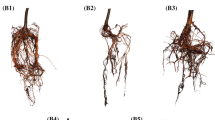Abstract
A new screening method was developed to evaluate resistance of leek (Allium porrum) to Phytophthora porri, based on inoculation by 24 h-immersion of leek plantlets in the 3–6 leaf stage in a suspension of ca. 100 zoospores.ml-1. The immersion test was used for identifying new sources of resistance and to determine the genetic basis of resistance. Within winter leek, five resistance classes were defined on the basis of average field scores of 21 plants. Clones from these plants were tested with the immersion technique. The average scores per resistance class in immersion and field tests were significantly correlated (P<0.01). The correlation of single-date field scores with the immersion test scores was better in the second half of the epidemic season. A selection experiment yielded a strong response to selection for resistance (53–97%) but no response to selection for susceptibility. This may indicate that resistance is due to few recessive genes in the studied winter leek. Crosses between landraces and winter leek were analyzed by means of F2 (selfed F1) and BC1, progenies. This analysis indicated the presence of few loci with dominant genes for resistance in accession CGN 873243, and additive polygenes in accession Pl 368351.
Similar content being viewed by others
References
Berninger, E. & P. Buret, 1967. Étude des déficients chlorophylliens chez deux espèces cultivées du genre Allium: l' oignon A. cepa L. et le poireau A. porrum L. Annales de l' Amélioration des Plantes 17: 175–194.
Bingham, E.T., R.W. Groose, D.R. Woodfield & K.K. Kidwell, 1994. Complementary gene interactions in alfalfa are greater in autotetraploids than diploids. Crop Science 34(4): 823–829.
Bos, I., 1980. About the advisable number of backcrosses for autotetraploid crops. Euphytica 29: 9–15.
Bradshaw, J.E., 1994. Quantitative genetics theory for tetrasomic inheritance. In: J.E. Bradshaw & G.R. Mackay (eds.) Potato genetics, CAB International, Wallingford, pp. 71–99.
Currah, L., 1986. Leek breeding: a review. Journal of Horticultural Science 61: 407–415.
Falconer, D.S., 1981. Introduction to quantitative genetics (2nd edition), Longman, London and New York, 340 pp.
Gagnebin F. & J.-C. Bonnet, 1979. Quelques considérations sur la culture et l'amélioration du poireau. Revue Horticole Suisse, 52: 112–116.
GENSTAT 5 Committee, 1987. Genstat 5 Reference Manual, Clarendon Press, Oxford: 310.
Gohil, R.N., 1984. Extent of recombination possible in the cultivated leek. In: Eucarpia 3rd Allium Symposium, IVT, Wageningen: 99–105.
Gray, D. & J.R.A. Steckel, 1986. The effects of seed-crop plant density, transplant size, harvest date and seed grading on leek (Allium porrum L.) seed quality. Journal of Horticultural Science, 61: 315–323.
Kampe, R., 1980. Untersuchungen zum Ausmass von Hybrideffekten bei Porree. Archiv für Züchtungsforschung, 10: 123–131.
Pink, D.A.C., 1993. Leek. In: G. Kalloo & B.O. Bergh (eds.) Genetic improvement of vegetable crops, Pergamon press, Oxford, New York, Seoul, Tokyo, pp. 29–34.
Potz, H., 1987. Untersuchungen zur genetischen Konstitution von Allium porrum L. (Diplomarbeit), University of Hannover, 65 pp.
Schweisguth, B., 1970. Études préliminaires à l'amélioration du poireau A. porrum. Proposition d'une méthode d'amélioration. Annales d'Amélioration des plantes, 20: 215–231
Silvertand, B., E. Jacobsen, J. Mazereeuw, P. Lavrijsen & A. van Harten, 1995. Efficient in vitro regeneration of leek (Allium ampeloprasum L.) via flower stalk segments. Plant Cell Reports 14: 423–427
Smith, B. & T.C. Crowther. Inbreeding depression and F1 hybrids in leeks (Allium ampeloprasum ssp. porrum L.). In press.
Smilde, W.D., M. van Nes & K. Reinink, 1995. Resistance to Phytophthora porri in leek and some of its wild relatives. Euphytica 83: 131–138.
Smilde, W.D., M. van Nes & H.D. Frinking. Effects of temperature on Phytophthora porri in vitro and in planta. European Journal of Plant Pathology, submitted.
Stack, S.M. & D. Roelofs. Localized chiasmata and recombination nodules in the tetraploid onion Allium porrum, submitted.
Van Marrewijk, N.P.A., 1988. Paraplurassen en EEG Verkeersregistratie van Groentegewassen. Jaarverslag RIVRO 1988: 26–30.
Wright, A.J., 1975. Phenotypic selection in autopolyploids. Heredity 35: 282–286.
Author information
Authors and Affiliations
Rights and permissions
About this article
Cite this article
Smilde, W., van Nes, M., Reinink, K. et al. Genetical studies of resistance to Phytophthora porri in Allium porrum, using a new early screening method. Euphytica 93, 345–352 (1997). https://doi.org/10.1023/A:1002900717062
Issue Date:
DOI: https://doi.org/10.1023/A:1002900717062



